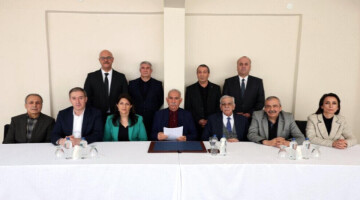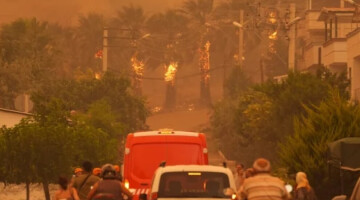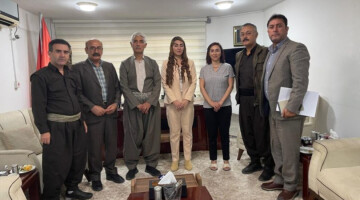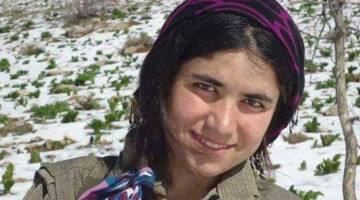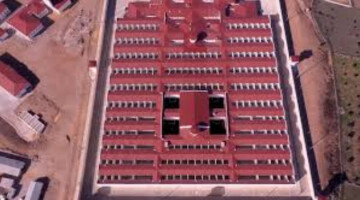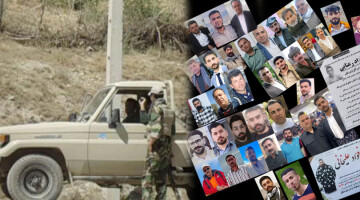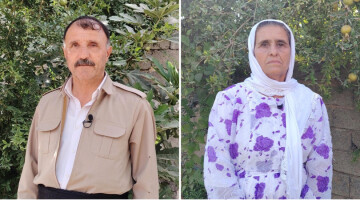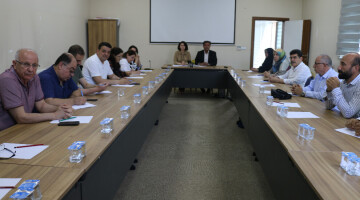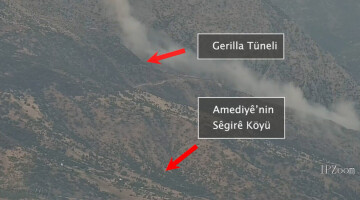After suffering heavy blows in the hands of YPG/YPJ combatants during the spring of 2014 and facing resistance to the attacks in all areas, ISIS gangs had understood that it would not be that easy to attack Kobanê.
The ISIS and the Turkish state, having understood that attacks on Kobanê with a certain number of groups wouldn't succeed, initiated their first strategic plan for the most possible comprehensive attacks from all fronts.
During the course of the June battle, border military posts of the Turkish state served as operational rooms where ISIS attacks were being managed. The Turkish state went beyond that, and gave further assistance to ISIS by providing the coordinates of YPG/YPJ points in the areas where ISIS gangs faced difficulties.
FIRST-TIME SIMULTANEOUS ATTACKS ON THREE FRONTS
The offensive of June began at June 2 night in the village of Evdiko in the east, Kunheftarê in the south and Zor Mîxare in the west. This was the first time ISIS gangs were conducting simultaneous attacks on Kobanê from three sides.
The assault was the most comprehensive one ever, as ISIS gangs as many as thousands used all kinds of heavy weaponry, tanks, artillery and missiles they had brought in from the Iraqi city of Mosul they had previously occupied.
In response to these attacks, YPG/YPJ forces, comprised of mainly new fighters in restricted numbers, started resistance with light arms that would perhaps have no effect at all against the weapons of the ISIS. The heaviest weapon of the YPG during that time was a hand-made Dushka machine gun.
BORDERS LOSING THEIR MEANING WITH ÖCALAN'S CALL FOR MOBILIZATION
While resistance was growing against the ISIS gangs that intensified their attacks on all three fronts, the only breathable area was the Northern Kurdistan side where, however, the Turkish state was providing assistance to the gang groups. The will of the Northern Kurdistan people then came into play against the Turkish state that used this area as a fourth front for the ISIS.
Acting upon the call made by Kurdish people's leader Abdullah Öcalan for mobilization after the beginning of the June offensive, the people of Northern Kurdistan turned the Ziyaret village at the border into a front of resistance.
The long resistance in Ziyaret village was aiming to hinder the support the Turkish state provided to ISIS gangs over the border, and it accomplished to a large extend.
The resistance in Ziyaret village meant a unity of the Northern and Western Kurdistan peoples, who already had a historical background of solidarity, and a de facto loss of meaning of the borders for the first time in history since drawn with the Treaty of Lausanne.
YOUTHS OF THE NORTH FLOCKED TO THE RANKS OF RESISTANCE
While the border line was turned into a front of resistance upon Öcalan's call, the youths of Northern Kurdistan exceeded the borders and joined the resistance in the ranks of YPG/YPJ.
The participation of hundreds of youths from Northern Kurdistan in the ranks of YPG/YPJ gave a great moral and strength to the people of Kobanê who had lost dozens of their children in the ranks of the PKK in the resistance of Northern Kurdistan. Kobanê resistance was raising the spirit of unity and solidarity in a way greater than any period.
STORIES OF BRAVERY INCREASING
As the dimension of attacks on Kobanê grew, stories of resistance and bravery were also increasing. YPG fighters under the command of Commander Botanê Reş started to write the June pages of the epic of Kobanê resistance against ISIS in the village of Evdiko.
Following a resistance of two days and two nights, YPG/YPJ fighters commanded by Botanê Reş inflicted heavy losses on ISIS gangs and repelled their attacks targeting Evdiko village with tanks and artillery. The resistance developed under the leadership of Botanê Reş on the eastern front did not allow the ISIS gangs to make an advance.
Against the ISIS groups that used their heavy weaponry force more effectively on the eastern front which was a plain and unprotected field, YPG/YPJ fighters were shielding each other with their own bodies and laying their bodies under tanks to neutralize them with bombs, through which they were slaughtering the gangs at this front.
ISIS gangs suffered heavy blows on this front, where they had been most effective, and this forced them to retreat from all the villages they had entered on the eastern front.
Botanê Reş, commander of the resistance on the eastern front, fell a martyr during a self-sacrificing action against gangs in later June, and became one of the symbols of the June's battle.
YPJ FIGHTERS BECOMING AN EPIC ON THE SOUTHERN FRONT
The same days witnessed the self-sacrificing resistance of YPJ fighters on the southern front. In late June, a group of 7 YPJ fighters was surrounded on the hill of Kûnheftarê village in and around which big accomplishments had been made against the gangs.
The resistance mounted by 7 female fighters led by Commander Avesta in an underground emplacement of the hill, and the divine effort and self-sacrifice made by their comrades to reach them, was summarizing the level of resistance on the southern front of Kobanê, and the reason why gangs couldn't make any advances here either.
Kobanê Commander Meryem Kobanê who was speaking to Avesta over radio during the encirclement, was saying; "Comrades, you will get out of that hill alive as long as we are here. Do not worry. We all will reach that hill, even if we all are killed, and push the DAIŞ (ISIS) away from the emplacement." Her words were being received with an ululation in joy. Answering Meryem Kobanê, Avesta was saying; "Even if you can not, we will resist with honour". There was literally a deadly run beginning against the time.
ISIS gangs, having failed to enter the emplacement of female fighters that resisted and inflicted blows on them, were wanting to set the surroundings of the hill on fire and poison the female fighters with smoke.
A number of combatants and the YPG/YPJ fighters resisting on three fronts mobilized that night, sent there reinforcements from all fronts which they saw off to the scene by saying; "We can fight for you too. You just go there and save our female comrades from the encirclement of the gangs".
As the sun started brightening Kobanê in the very early morning hours, Commander Meryem and her combatants were telling about the faces of their comrades that bravely resisted in the underground emplacement in Kûnheftarê hill. The seven female fighters had been taken out of the emplacement as a result of daring resistance.
Gangs were being inflicted heavy blows in every village on the southern front, and hindered from making advances.
WESTERN FRONT COORDINATED BY THE TURKISH STATE
The western front was mainly housing hills, thanks to which gangs weren't being able hold on against YPG/YPJ combatants, and were suffering the heaviest blows in comparison to other fronts.
YPG fighter Botanê Sor’s action against gangs in the village of Zor Mîxare was being described by YPG/YPJ commanders as; "the moment that broke the will of DAIŞ in this offensive".
After entering the village of Zor Mîxare all alone, Botanê Sor fights with hand grenades and kills dozens of gang members. Getting wounded during the battle, Botanê Sor doesn't listen to his commanders' warning to “stay there, we will get you out", as he advances on the gangs with his last grenade and kills dozens more before he loses his life there.
It happens the Turkish state to come to the rescue of the ISIS that suffered a major panic and failure on this front after this action, providing the gangs with the coordination of the YPG/YPJ fighters on this front.
ISIS gangs had remained desperate in the wake of the one-man resistance put up by YPG Commander Hogir Garzan on Zagros Hill overlooking the village of Ziyaret. Provided with the coordinates of Commander Garzan's position from the border military post of the Turkish state, gangs launched tank fire on this area, which left commander Garzan martyred.
ISIS DEFEAT ON THREE FRONTS
Following its emergence, ISIS suffered the first defeat, the first failure and the first retreat during the June resistance in Kobanê. Following their one month long attacks, ISIS gangs suffered heavy losses and started to flee. While withdrawing their forces back to their previous line on the eastern and southern fronts, the gangs on the western front had to leave a part of the Şexler line, which had entirely been under their control previously.
JULY OFFENSIVE
Following the flight of the gangs, YPG/YPJ combatants initiated the "Kobanê Martyrs Revenge Operation" which lasted throughout the month of July and witnessed heavy losses on the side of the ISIS. Dozens of villages held by ISIS before the June offensive were taken back and liberated on all three fronts.
After suffering a major defeat in the first major attack on Kobanê, ISIS gangs retreated from Kobanê in late July and headed towards the towns of Deir-e Zor and Tabqa which were held by the regime and housed a large number of heavy weapons and munitions.
In early August, gangs started their attacks on Shengal.
During the month of August, Kobanê witnessed silent and small scale clashes, and an enhancement of the works for reconstruction.
However, with the sort of presentation of the huge heavy weaponry force in Deir-e Zor and Tabqa to the gangs by the Syrian regime, it was understood that this silence was the calm before the storm.

